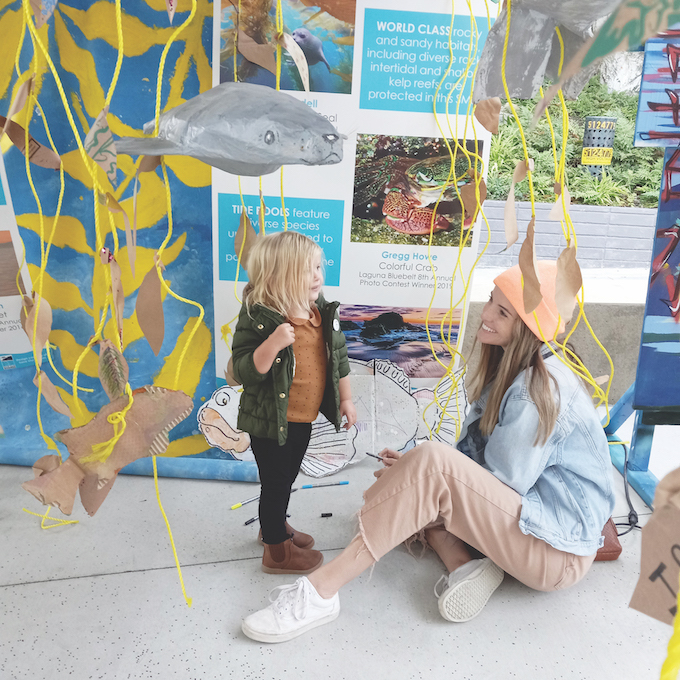
Laguna Bluebelt Coalition safeguards marine sanctuaries and preserves coastal integrity.
By Tanya A. Yacina
The Laguna Bluebelt Coalition brings together organizations and people with a common goal of protecting and restoring local marine life, conserving biological diversity and maintaining healthy, sustainable marine habitats. Developed organically in 2008, the group works to create and advance Marine Protected Areas in Laguna Beach and restore its marine life and habitat.
“The Laguna Bluebelt Coalition has become recognized as a dynamic example of community collaboration and success. Most of the community now accepts and even promotes Laguna’s MPAs,” says co-founder Mike Beanan. “For more than 10 years, the City Council and staff have worked with us to perfect the necessary policies and procedures needed for successful MPAs. Support from Marine Safety lifeguards and community activists plays a leading role in overcoming obstacles to create citywide enforcement of rules and regulations protecting marine life.”

Beanan says the coalition was designed to promote collaboration among all stakeholder groups, including fishing interests and wastewater agencies, to follow the science in negotiating the boundaries of Laguna’s MPAs. The early Laguna Bluebelt Coalition model now also serves as a template for 14 statewide collaboratives managing California’s MPAs.
“The coalition has demonstrated an MPA in a highly urbanized area can succeed by working together with all stakeholders and relevant agencies,” Beanan says. “The Laguna Bluebelt is now a showcase example of sea life recovery with widespread community support. However, protecting the ocean and sea life is never done and we continue multiple efforts to improve ocean water quality for sea life to survive and thrive.”
This alliance works with other agencies to raise awareness and protect the marine environment.

Berm Buddies
Several years ago, the Laguna Bluebelt Coalition received grants to create the Aliso Berm Buddies program to educate the public and monitor the beach sand berm. County and inland water districts joined the effort, and signs with county ordinances were posted to increase enforcement protecting the berm, safe public access and sea life. “Aliso Creek transports urban runoff from five inland cities to Aliso Beach and remains the biggest source of routine ocean pollution,” explains Mike Beanan, co-founder of thea coalition. “The naturally occurring Aliso Beach Sand Berm functions as a barrier to prevent urban runoff from reaching MPAs. With the annexation of south Laguna’s beaches one year ago, county signage has been removed as the city develops new rules to protect the sand berm. The Aliso Berm Buddies program, coordinated by OC Coastkeeper and staffed by marine scientists and volunteers, continues weekly monitoring activities at the Bluebelt booth … at the mouth of Aliso Creek.”

Sea Life Snapshots
“Laguna Beach has many talented photographers capturing the numerous ways we enjoy the MPAs on the beach and above or under the water,” Beanan says. “The annual Laguna Bluebelt Photo Contest began 13 years ago to showcase photos as a way to inspire the community and elected officials to find ways to advance sea life protection. These images bring to the surface the habitats and sea life that are mostly invisible to inspire a greater awareness of Laguna’s unique and precious marine environments.” The photographs are meant to chronicle the success of Laguna’s MPAs in kelp forest recovery and the abundant sea life that follows the return of key species. The contest has helped elevate the awareness of the Laguna Bluebelt locally and statewide. Anyone, from amateur photographers to professionals, can compete for cash prizes. Winners are featured by local news outlets and their work is displayed at the downtown LCAD Gallery. Enter online through June 22 at lagunabluebelt.org.

Coloring the Coast
Laguna’s kelp forests grow as much as 2 feet per day and are the fastest-growing plant on the planet, capturing 30% of atmospheric carbon, according to Beanan. However, kelp forests are mostly invisible to the public, so 10 years ago, art students at Orange Coast College created a coloring book to highlight benefits of these underwater habitats. “As kids learn about kelp forests, they can educate their parents to urge elected officials to do more now to protect the health of the ocean,” Beanan says. “An early education can lead students to pursue … marine sciences and lead the next generation … to seek sustainable solutions to ocean pollution.” Kelp Coloring Books can be downloaded at lagunabluebelt.org.
